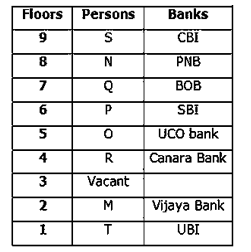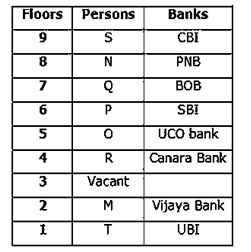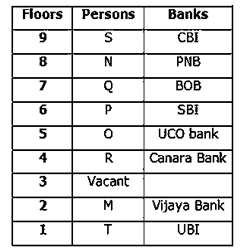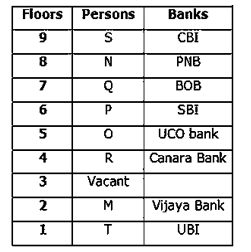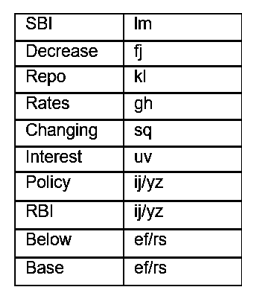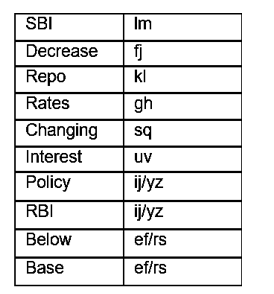Question 1:
Direction: Study the following information carefully and answer the questions given below:
निर्देश: नीचे दी गई जानकारी को ध्यान से पढ़ें और निम्नलिखित प्रश्नों का उत्तर दें।
Eight persons M, N, O, P, Q, R, S, and T are living on different floors of a nine-story building and one is vacant. The ground floor is numbered 1, the above floor is numbered 2 and so on till the topmost floor is numbered 9. Each one of them works in different banks i.e. SBI, PNB, BOB, CBI, UCO Bank, Canara Bank, Vijaya Bank and UBI, but not necessarily in the same order.
O lives on floor numbered 5 but not works in BOB. The vacant floor is on odd numbered floor but not on topmost floor. There are two persons Live between P and the one who works in Vijaya bank. N lives immediately above the one who works in BOB. T lives immediately below the one who works in Vijaya Bank and does not work in BOB. The one who works in UBI lives on lowermost floor. Only one floor is between Q and the one who is works in CBI. S doesn’t live on floor number 2. P doesn’t live on odd numbered floor and lives one of the floors above the one who works in Vijaya Bank. N doesn’t live an odd numbered floor. R works in Canara Bank but doesn’t live on odd numbered floor. N doesn’t work in UCO Bank. Only one person lives between the one who works in SBI and the one who works in Canara Bank. O does not work in CBI.
आठ व्यक्ति M, N, O, P, Q, R, S, और T नौ मंजिला इमारत के विभिन्न मंजिल पर रह रहे हैं और एक खाली मंजिल है। सबसे निचले मंजिल को 1 गिना जाता है, उसके ऊपर के मंजिल को 2 गिना जाता है और इसप्रकार शीर्ष मंजिल की संख्या 9 है। उनमें से प्रत्येक अलग-अलग बैंकों अर्थात एसबीआई, पीएनबी, बीओबी, सीबीआई, यूको बैंक, केनरा बैंक, विजया बैंक और यूबीआई में काम करते है , लेकिन एक ही क्रम में जरूरी नहीं है।
O मंजिल संख्या 5 पर रहता है परन्तु बीओबी में काम नहीं करता है। खाली मंजिल विषम क्रमांकित मंजिल है लेकिन शीर्ष मंजिल नहीं है। P और जो विजया बैंक में काम करता है के बीच दो लोग रहते हैं। N बीओबी में काम करने वाले व्यक्ति के तुरंत ऊपर रहता है। T विजया बैंक में काम करने वालेव्यक्ति के ठीक नीचे रहता है और बीओबी में काम नहीं करता है। जो यूबीआई में काम करता है वह सबसे निचली मंजिल पर रहता है। Q और जो सीबीआई में काम करता है, के बीच केवल एक मंजिल है। S मंजिल 2 पर नहीं रहता है। P विषम क्रमांकित मंजिल पर नहीं रहता है और विजया बैंक में काम करने वाले व्यक्ति के ऊपर की मंजिलों में रहता है। N विषम क्रमांकित मंजिल पर नहीं रहता है। R कैनरा बैंक में काम करता है लेकिन विषम क्रमांकित मंजिल पर नहीं रहता है।U यूको बैंक में काम नहीं करता है। केवल एक व्यक्ति एसबीआई में काम करने वाले व्यक्ति और कैनरा बैंक में काम करने वाले व्यक्ति के बीच रहता है। O सीबीआई में काम नहीं करता है।
The one who works in UCO Bank lives on which of the following floor?
जो यूको बैंक में काम करता है वह निम्नलिखित में से किस मंजिल पर रहता है?
Question 2:
Direction: Study the following information carefully and answer the questions given below:
निर्देश: नीचे दी गई जानकारी को ध्यान से पढ़ें और निम्नलिखित प्रश्नों का उत्तर दें।
Eight persons M, N, O, P, Q, R, S, and T are living on different floors of a nine-story building and one is vacant. The ground floor is numbered 1, the above floor is numbered 2 and so on till the topmost floor is numbered 9. Each one of them works in different banks i.e. SBI, PNB, BOB, CBI, UCO Bank, Canara Bank, Vijaya Bank and UBI, but not necessarily in the same order.
O lives on floor numbered 5 but not works in BOB. The vacant floor is on odd numbered floor but not on topmost floor. There are two persons Live between P and the one who works in Vijaya bank. N lives immediately above the one who works in BOB. T lives immediately below the one who works in Vijaya Bank and does not work in BOB. The one who works in UBI lives on lowermost floor. Only one floor is between Q and the one who is works in CBI. S doesn’t live on floor number 2. P doesn’t live on odd numbered floor and lives one of the floors above the one who works in Vijaya Bank. N doesn’t live an odd numbered floor. R works in Canara Bank but doesn’t live on odd numbered floor. N doesn’t work in UCO Bank. Only one person lives between the one who works in SBI and the one who works in Canara Bank. O does not work in CBI.
आठ व्यक्ति M, N, O, P, Q, R, S, और T नौ मंजिला इमारत के विभिन्न मंजिल पर रह रहे हैं और एक खाली मंजिल है। सबसे निचले मंजिल को 1 गिना जाता है, उसके ऊपर के मंजिल को 2 गिना जाता है और इसप्रकार शीर्ष मंजिल की संख्या 9 है। उनमें से प्रत्येक अलग-अलग बैंकों अर्थात एसबीआई, पीएनबी, बीओबी, सीबीआई, यूको बैंक, केनरा बैंक, विजया बैंक और यूबीआई में काम करते है , लेकिन एक ही क्रम में जरूरी नहीं है।
O मंजिल संख्या 5 पर रहता है परन्तु बीओबी में काम नहीं करता है। खाली मंजिल विषम क्रमांकित मंजिल है लेकिन शीर्ष मंजिल नहीं है। P और जो विजया बैंक में काम करता है के बीच दो लोग रहते हैं। N बीओबी में काम करने वाले व्यक्ति के तुरंत ऊपर रहता है। T विजया बैंक में काम करने वालेव्यक्ति के ठीक नीचे रहता है और बीओबी में काम नहीं करता है। जो यूबीआई में काम करता है वह सबसे निचली मंजिल पर रहता है। Q और जो सीबीआई में काम करता है, के बीच केवल एक मंजिल है। S मंजिल 2 पर नहीं रहता है। P विषम क्रमांकित मंजिल पर नहीं रहता है और विजया बैंक में काम करने वाले व्यक्ति के ऊपर की मंजिलों में रहता है। N विषम क्रमांकित मंजिल पर नहीं रहता है। R कैनरा बैंक में काम करता है लेकिन विषम क्रमांकित मंजिल पर नहीं रहता है।U यूको बैंक में काम नहीं करता है। केवल एक व्यक्ति एसबीआई में काम करने वाले व्यक्ति और कैनरा बैंक में काम करने वाले व्यक्ति के बीच रहता है। O सीबीआई में काम नहीं करता है।
Q works in which of the following bank?
Q निम्नलिखित बैंक में से किसमें काम करता है?
Question 3:
Direction: Study the following information carefully and answer the questions given below:
निर्देश: नीचे दी गई जानकारी को ध्यान से पढ़ें और निम्नलिखित प्रश्नों का उत्तर दें।
Eight persons M, N, O, P, Q, R, S, and T are living on different floors of a nine-story building and one is vacant. The ground floor is numbered 1, the above floor is numbered 2 and so on till the topmost floor is numbered 9. Each one of them works in different banks i.e. SBI, PNB, BOB, CBI, UCO Bank, Canara Bank, Vijaya Bank and UBI, but not necessarily in the same order.
O lives on floor numbered 5 but not works in BOB. The vacant floor is on odd numbered floor but not on topmost floor. There are two persons Live between P and the one who works in Vijaya bank. N lives immediately above the one who works in BOB. T lives immediately below the one who works in Vijaya Bank and does not work in BOB. The one who works in UBI lives on lowermost floor. Only one floor is between Q and the one who is works in CBI. S doesn’t live on floor number 2. P doesn’t live on odd numbered floor and lives one of the floors above the one who works in Vijaya Bank. N doesn’t live an odd numbered floor. R works in Canara Bank but doesn’t live on odd numbered floor. N doesn’t work in UCO Bank. Only one person lives between the one who works in SBI and the one who works in Canara Bank. O does not work in CBI.
आठ व्यक्ति M, N, O, P, Q, R, S, और T नौ मंजिला इमारत के विभिन्न मंजिल पर रह रहे हैं और एक खाली मंजिल है। सबसे निचले मंजिल को 1 गिना जाता है, उसके ऊपर के मंजिल को 2 गिना जाता है और इसप्रकार शीर्ष मंजिल की संख्या 9 है। उनमें से प्रत्येक अलग-अलग बैंकों अर्थात एसबीआई, पीएनबी, बीओबी, सीबीआई, यूको बैंक, केनरा बैंक, विजया बैंक और यूबीआई में काम करते है , लेकिन एक ही क्रम में जरूरी नहीं है।
O मंजिल संख्या 5 पर रहता है परन्तु बीओबी में काम नहीं करता है। खाली मंजिल विषम क्रमांकित मंजिल है लेकिन शीर्ष मंजिल नहीं है। P और जो विजया बैंक में काम करता है के बीच दो लोग रहते हैं। N बीओबी में काम करने वाले व्यक्ति के तुरंत ऊपर रहता है। T विजया बैंक में काम करने वालेव्यक्ति के ठीक नीचे रहता है और बीओबी में काम नहीं करता है। जो यूबीआई में काम करता है वह सबसे निचली मंजिल पर रहता है। Q और जो सीबीआई में काम करता है, के बीच केवल एक मंजिल है। S मंजिल 2 पर नहीं रहता है। P विषम क्रमांकित मंजिल पर नहीं रहता है और विजया बैंक में काम करने वाले व्यक्ति के ऊपर की मंजिलों में रहता है। N विषम क्रमांकित मंजिल पर नहीं रहता है। R कैनरा बैंक में काम करता है लेकिन विषम क्रमांकित मंजिल पर नहीं रहता है।U यूको बैंक में काम नहीं करता है। केवल एक व्यक्ति एसबीआई में काम करने वाले व्यक्ति और कैनरा बैंक में काम करने वाले व्यक्ति के बीच रहता है। O सीबीआई में काम नहीं करता है।
Which of the following floor number is Vacant?
निम्नलिखित में से कौन सी मंजिल खाली है?
Question 4:
Direction: Study the following information carefully and answer the questions given below:
निर्देश: नीचे दी गई जानकारी को ध्यान से पढ़ें और निम्नलिखित प्रश्नों का उत्तर दें।
Eight persons M, N, O, P, Q, R, S, and T are living on different floors of a nine-story building and one is vacant. The ground floor is numbered 1, the above floor is numbered 2 and so on till the topmost floor is numbered 9. Each one of them works in different banks i.e. SBI, PNB, BOB, CBI, UCO Bank, Canara Bank, Vijaya Bank and UBI, but not necessarily in the same order.
O lives on floor numbered 5 but not works in BOB. The vacant floor is on odd numbered floor but not on topmost floor. There are two persons Live between P and the one who works in Vijaya bank. N lives immediately above the one who works in BOB. T lives immediately below the one who works in Vijaya Bank and does not work in BOB. The one who works in UBI lives on lowermost floor. Only one floor is between Q and the one who is works in CBI. S doesn’t live on floor number 2. P doesn’t live on odd numbered floor and lives one of the floors above the one who works in Vijaya Bank. N doesn’t live an odd numbered floor. R works in Canara Bank but doesn’t live on odd numbered floor. N doesn’t work in UCO Bank. Only one person lives between the one who works in SBI and the one who works in Canara Bank. O does not work in CBI.
आठ व्यक्ति M, N, O, P, Q, R, S, और T नौ मंजिला इमारत के विभिन्न मंजिल पर रह रहे हैं और एक खाली मंजिल है। सबसे निचले मंजिल को 1 गिना जाता है, उसके ऊपर के मंजिल को 2 गिना जाता है और इसप्रकार शीर्ष मंजिल की संख्या 9 है। उनमें से प्रत्येक अलग-अलग बैंकों अर्थात एसबीआई, पीएनबी, बीओबी, सीबीआई, यूको बैंक, केनरा बैंक, विजया बैंक और यूबीआई में काम करते है , लेकिन एक ही क्रम में जरूरी नहीं है।
O मंजिल संख्या 5 पर रहता है परन्तु बीओबी में काम नहीं करता है। खाली मंजिल विषम क्रमांकित मंजिल है लेकिन शीर्ष मंजिल नहीं है। P और जो विजया बैंक में काम करता है के बीच दो लोग रहते हैं। N बीओबी में काम करने वाले व्यक्ति के तुरंत ऊपर रहता है। T विजया बैंक में काम करने वालेव्यक्ति के ठीक नीचे रहता है और बीओबी में काम नहीं करता है। जो यूबीआई में काम करता है वह सबसे निचली मंजिल पर रहता है। Q और जो सीबीआई में काम करता है, के बीच केवल एक मंजिल है। S मंजिल 2 पर नहीं रहता है। P विषम क्रमांकित मंजिल पर नहीं रहता है और विजया बैंक में काम करने वाले व्यक्ति के ऊपर की मंजिलों में रहता है। N विषम क्रमांकित मंजिल पर नहीं रहता है। R कैनरा बैंक में काम करता है लेकिन विषम क्रमांकित मंजिल पर नहीं रहता है।U यूको बैंक में काम नहीं करता है। केवल एक व्यक्ति एसबीआई में काम करने वाले व्यक्ति और कैनरा बैंक में काम करने वाले व्यक्ति के बीच रहता है। O सीबीआई में काम नहीं करता है।
If Q is related to CBI, P is related to PNB, in the same way T is related to which of the following?
यदि Q सीबीआई से संबंधित है, P पीएनबी से संबंधित है, वैसे ही T निम्नलिखित में से किस बैंक से संबंधित है?
Question 5:
Direction: Study the following information carefully and answer the questions given below:
निर्देश: नीचे दी गई जानकारी को ध्यान से पढ़ें और निम्नलिखित प्रश्नों का उत्तर दें।
Eight persons M, N, O, P, Q, R, S, and T are living on different floors of a nine-story building and one is vacant. The ground floor is numbered 1, the above floor is numbered 2 and so on till the topmost floor is numbered 9. Each one of them works in different banks i.e. SBI, PNB, BOB, CBI, UCO Bank, Canara Bank, Vijaya Bank and UBI, but not necessarily in the same order.
O lives on floor numbered 5 but not works in BOB. The vacant floor is on odd numbered floor but not on topmost floor. There are two persons Live between P and the one who works in Vijaya bank. N lives immediately above the one who works in BOB. T lives immediately below the one who works in Vijaya Bank and does not work in BOB. The one who works in UBI lives on lowermost floor. Only one floor is between Q and the one who is works in CBI. S doesn’t live on floor number 2. P doesn’t live on odd numbered floor and lives one of the floors above the one who works in Vijaya Bank. N doesn’t live an odd numbered floor. R works in Canara Bank but doesn’t live on odd numbered floor. N doesn’t work in UCO Bank. Only one person lives between the one who works in SBI and the one who works in Canara Bank. O does not work in CBI.
आठ व्यक्ति M, N, O, P, Q, R, S, और T नौ मंजिला इमारत के विभिन्न मंजिल पर रह रहे हैं और एक खाली मंजिल है। सबसे निचले मंजिल को 1 गिना जाता है, उसके ऊपर के मंजिल को 2 गिना जाता है और इसप्रकार शीर्ष मंजिल की संख्या 9 है। उनमें से प्रत्येक अलग-अलग बैंकों अर्थात एसबीआई, पीएनबी, बीओबी, सीबीआई, यूको बैंक, केनरा बैंक, विजया बैंक और यूबीआई में काम करते है , लेकिन एक ही क्रम में जरूरी नहीं है।
O मंजिल संख्या 5 पर रहता है परन्तु बीओबी में काम नहीं करता है। खाली मंजिल विषम क्रमांकित मंजिल है लेकिन शीर्ष मंजिल नहीं है। P और जो विजया बैंक में काम करता है के बीच दो लोग रहते हैं। N बीओबी में काम करने वाले व्यक्ति के तुरंत ऊपर रहता है। T विजया बैंक में काम करने वालेव्यक्ति के ठीक नीचे रहता है और बीओबी में काम नहीं करता है। जो यूबीआई में काम करता है वह सबसे निचली मंजिल पर रहता है। Q और जो सीबीआई में काम करता है, के बीच केवल एक मंजिल है। S मंजिल 2 पर नहीं रहता है। P विषम क्रमांकित मंजिल पर नहीं रहता है और विजया बैंक में काम करने वाले व्यक्ति के ऊपर की मंजिलों में रहता है। N विषम क्रमांकित मंजिल पर नहीं रहता है। R कैनरा बैंक में काम करता है लेकिन विषम क्रमांकित मंजिल पर नहीं रहता है।U यूको बैंक में काम नहीं करता है। केवल एक व्यक्ति एसबीआई में काम करने वाले व्यक्ति और कैनरा बैंक में काम करने वाले व्यक्ति के बीच रहता है। O सीबीआई में काम नहीं करता है।
Which of the following combination is true?
निम्नलिखित में से कौन सा संयोजन सत्य है?
Question 6:
Direction: Study the following information carefully and answer the questions given below:
निर्देश: निम्नलिखित जानकारी का ध्यानपूर्वक अध्ययन करें और नीचे दिए गए प्रश्नों का उत्तर दें:
In a certain code, एक निश्चित कोड में,
“SBI decrease repo rates” को “lm fj kl gh” के रूप में कोडित किया गया है
“RBI changing policy rates” को “gh sq ij yz” के रूप में कोडित किया गया है
“SBI changing interest rates” को “gh uv lm sq” के रूप में कोडित किया गया है
“SBI repo below base rates” को “kl lm ef rs gh” के रूप में कोडित किया गया है
“SBI decrease repo rates” coded as “lm fj kl gh”
“RBI changing policy rates” coded as “gh sq ij yz”
“SBI changing interest rates” coded as “gh uv lm sq”
“SBI repo below base rates” coded as “kl lm ef rs gh”
What is the code for “decrease” in this code language?
इस कोड भाषा में “decrease” के लिए कोड क्या है?
Question 7:
Direction: Study the following information carefully and answer the questions given below:
निर्देश: निम्नलिखित जानकारी का ध्यानपूर्वक अध्ययन करें और नीचे दिए गए प्रश्नों का उत्तर दें:
In a certain code, एक निश्चित कोड में,
“SBI decrease repo rates” को “lm fj kl gh” के रूप में कोडित किया गया है
“RBI changing policy rates” को “gh sq ij yz” के रूप में कोडित किया गया है
“SBI changing interest rates” को “gh uv lm sq” के रूप में कोडित किया गया है
“SBI repo below base rates” को “kl lm ef rs gh” के रूप में कोडित किया गया है
“SBI decrease repo rates” coded as “lm fj kl gh”
“RBI changing policy rates” coded as “gh sq ij yz”
“SBI changing interest rates” coded as “gh uv lm sq”
“SBI repo below base rates” coded as “kl lm ef rs gh”
What is the code for “rates” in this code language?
इस कोड भाषा में “rates” के लिए कोड क्या है?
Question 8:
Direction: Study the following information carefully and answer the questions given below:
निर्देश: निम्नलिखित जानकारी का ध्यानपूर्वक अध्ययन करें और नीचे दिए गए प्रश्नों का उत्तर दें:
In a certain code, एक निश्चित कोड में,
“SBI decrease repo rates” को “lm fj kl gh” के रूप में कोडित किया गया है
“RBI changing policy rates” को “gh sq ij yz” के रूप में कोडित किया गया है
“SBI changing interest rates” को “gh uv lm sq” के रूप में कोडित किया गया है
“SBI repo below base rates” को “kl lm ef rs gh” के रूप में कोडित किया गया है
“SBI decrease repo rates” coded as “lm fj kl gh”
“RBI changing policy rates” coded as “gh sq ij yz”
“SBI changing interest rates” coded as “gh uv lm sq”
“SBI repo below base rates” coded as “kl lm ef rs gh”
Which of the following word comes for the code “kl” in this code language?
इस कोड भाषा में कोड “kl” के लिए निम्न में से कौन सा शब्द आता है?
Question 9:
Direction: Study the following information carefully and answer the questions given below:
निर्देश: निम्नलिखित जानकारी का ध्यानपूर्वक अध्ययन करें और नीचे दिए गए प्रश्नों का उत्तर दें:
In a certain code, एक निश्चित कोड में,
“SBI decrease repo rates” को “lm fj kl gh” के रूप में कोडित किया गया है
“RBI changing policy rates” को “gh sq ij yz” के रूप में कोडित किया गया है
“SBI changing interest rates” को “gh uv lm sq” के रूप में कोडित किया गया है
“SBI repo below base rates” को “kl lm ef rs gh” के रूप में कोडित किया गया है
“SBI decrease repo rates” coded as “lm fj kl gh”
“RBI changing policy rates” coded as “gh sq ij yz”
“SBI changing interest rates” coded as “gh uv lm sq”
“SBI repo below base rates” coded as “kl lm ef rs gh”
Which of the following word comes for the code “uv” in this code language?
इस कोड भाषा में कोड “uv” के लिए निम्न में से कौन सा शब्द आता है?
Question 10:
Direction: Study the following information carefully and answer the questions given below:
निर्देश: निम्नलिखित जानकारी का ध्यानपूर्वक अध्ययन करें और नीचे दिए गए प्रश्नों का उत्तर दें:
In a certain code, एक निश्चित कोड में,
“SBI decrease repo rates” को “lm fj kl gh” के रूप में कोडित किया गया है
“RBI changing policy rates” को “gh sq ij yz” के रूप में कोडित किया गया है
“SBI changing interest rates” को “gh uv lm sq” के रूप में कोडित किया गया है
“SBI repo below base rates” को “kl lm ef rs gh” के रूप में कोडित किया गया है
“SBI decrease repo rates” coded as “lm fj kl gh”
“RBI changing policy rates” coded as “gh sq ij yz”
“SBI changing interest rates” coded as “gh uv lm sq”
“SBI repo below base rates” coded as “kl lm ef rs gh”
What maybe the code for “RBI withdraw policy rates” in this code language?
इस कोड भाषा में “RBI withdraw policy rates” के लिए संभावित कोड क्या है?

